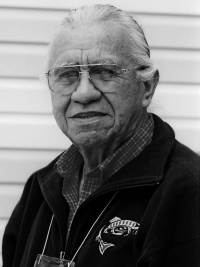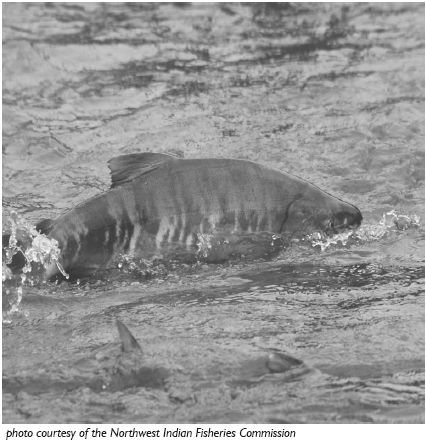Being Frank: We Have to be Salmon ToughBy Billy Frank
We need to be as tough as the salmon themselves if we're going to see their recovery. South Fork Nooksack River native spring chinook are almost extinct and need our help. It wasn't long ago when about 13,000 of these early-timed chinook came back to the river each year. They were the first salmon to arrive each spring, feeding Indian people after long winters, when no other salmon were in the river. Spring chinook have a much tougher journey than other salmon because they spend more time in fresh water before spawning. They are especially sensitive to poor habitat conditions in the river. Time has not been kind to salmon habitat in the South Fork Nooksack. The loss of trees and other plants along streams has removed important shade and reduced the source of wood needed for in-stream fish habitat. Spring chinook need deep, sheltered pools of cool water for their extended rest before they spawn. Water that is too warm can result in disease, reduced salmon egg survival and even death.
This summer, to give the river the building blocks it needs to restore degraded habitat, both the Lummi Nation and the Nooksack Tribe built specially engineered logjams in the South Fork. Over the next few years, these logjams will help create the deep pools that young and adult salmon prefer. While we are fixing the habitat, we also have to make sure that we are protecting the unique genetic traits of these fish. The Lummi Nation and the Nooksack Tribe are working with the state Department of Fish and Wildlife and the National Oceanic and Atmospheric Administration on an important program to raise juvenile South Fork Nooksack River chinook in captivity and spawn them. Their offspring will be released in the river to migrate naturally and return as adults a few years later. Our goal for this stock is the same for all wild salmon stocks: to recover their populations to levels that can again support harvest. By taking these naturally spawned juvenile chinook into protective custody, the tribes are safeguarding their future. The path to recovery takes a side-by-side approach of boosting numbers now while also fixing the habitat so the river can support a healthy, productive population. I'm proud that the tribes are taking a leadership role in both areas. Salmon face great challenges during their life journey. With their numbers falling, we have to work harder to help them on their way. As long as they continue to swim upstream, so should we. Billy Frank Jr. is the chairman of the Northwest Indian Fisheries Commission.
Back to Home page. |


